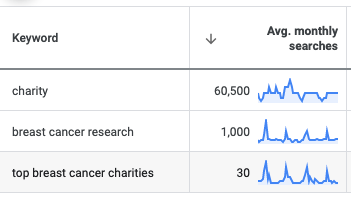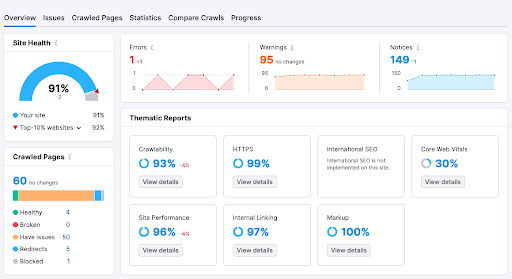5 Essential Steps for Nonprofits to Build SEO Strategy [+ Tools]
Even nonprofits need to invest in digital marketing, SEO in particular. Follow this step-by-step guide for nonprofits looking to build their own SEO strategy.
SEO (search engine optimization) is an often overlooked element of digital marketing for nonprofits. Many organizations understand the value of building a captivating website, investing in social media and content marketing, and even running digital ad campaigns, but when it comes to SEO implementation there is confusion and hesitation.
Nonprofits can greatly benefit from investing into SEO because it allows organizations to effectively compete for top visibility without spending hefty ad dollars. SEO is a long-term strategy that requires a careful and strategic approach, but results in sustainable growth through organic search. By leveraging SEO, you increase awareness of your mission to people that are specifically searching within your industry. This leads to more beneficiaries, advocates, volunteers, and donors to your nonprofit.
In this article, we want to break down the complexity of creating an SEO strategy by using a 5-step process that will position your nonprofit for SEO success.
- Define the goal
- Know your audience & intent
- Balance intent with volume
- Use research and data
- Plan onsite and offsite tactics
Looking to improve your SEO strategy? Search top service providers on Top Design Firms.
Need help selecting a company?
Based on your budget, timeline, and specifications we can help you build a shortlist of companies that perfectly matches your project needs. Get started by submitting your project details.
1. Define the Goal
Every strategy requires a goal. When developing an SEO strategy, you need to know what you want to accomplish with your website. And wanting “more website traffic” is not enough to help with concrete planning or decision-making down the road. Defining a specific objective will guide your efforts and make clear what needs to happen in order to achieve your SEO goal.
For example, if your goal is to attract younger donors through organic search, you may focus on creating social justice campaigns with dedicated donation pages optimized for keywords. On the other hand, if your goal is to attract volunteers, the focus should be on improving local SEO and generating engaging content and resources.
2. Know Your Audience + Intent
Any form of marketing requires an understanding of who it is you are trying to reach. When it comes to SEO, you will rely more on a person’s intentions over their demographic information because the primary method of targeting people will be through their search queries.
So when starting your SEO journey, the strategy must start with the question: what intentions do you want to target?
The way to understand intent is by understanding the words that are commonly used to express that intent. For example, someone browsing for a charity to support may simply search the phrase “best charities,” but may not immediately have intentions to donate. A more specific search phrase like “best cancer charities to donate” indicates much higher intent and higher probability of donating.
The latter term will inevitably have much less search volume because of its specificity, but narrows down the audience to people specifically seeking a cancer-based charity to donate to. These search phrases are called “keywords” and will be the gateway to understanding your target audience.
3. Balance Intent with Volume
Finding the best keyword is not just going for the most searched keywords or capturing the most specific intents. Keywords need to balance a healthy amount of search volume with sufficient intent that leads to an action with your nonprofit.
Imagine you run a nonprofit that is seeking donors to support your breast cancer research and awareness efforts. According to Google Keyword Planner, a common keyword like “charity” has over 60,000 monthly search volume in the U.S., whereas “top breast cancer charities” only shows a monthly volume of around 20 searches.
Targeting for “charity” has great traffic potential, but the inability to target specific intent will lead to suboptimal traffic. Not to mention, the greater the search volume the more competition you will face to stand out and rank highly.

On the other hand, “top breast cancer charities” may have too little search volume to make a meaningful impact. Therefore, a keyword like “breast cancer research” which has over 1,000 monthly searches will allow your organization to find an ample volume of meaningful intent.
4. Use Research and Data
Once you have an idea of the keywords you want to target, it is essential to do some homework. Analyze the keywords amongst your competitors, evaluate how competitive it will be in terms of cost and time to improve your ranking, and assess your website to determine how to optimize for a targeted keyword. Having a comprehensive audit will give you a measurement of where you are now, so that you can better plan for where you want to be.
In order to efficiently and effectively run an audit, leveraging SEO tools will streamline a lot of the work.
There is an overwhelming amount of tools that exist today, but we listed some of the most popular softwares used by marketers today.

Top SEO Tools
Ahrefs
- Ahrefs is one of the most recommended SEO tools on the market. It is an all-in-one SEO platform that is fairly straightforward to use. It helps you easily track your website position on search results and provides a range of keyword research tools. Pricing starts at $99/mo.
- Best overall.
Semrush
- Semrush is one of the most comprehensive SEO tools available. It allows for detailed analysis of competition and provides recommendations for your onsite and offsite strategies. Pricing starts at $119/mo.
- Best for detailed insights.
Moz Pro
- Moz Pro is great for beginners as it has a simple interface, but still powerful in its features that are comparable to Ahrefs and Semrush. Pricing starts at $99/mo.
- Best for ease-of-use.
- Google has two distinct tools that complements SEO: Google Search Console and Google Keyword Planner.
- Search Console is used primarily to track your ranking positions for search queries used to find your site. It also has other features to help monitor your onsite health and search traffic.
- Keyword Planner is a simple tool to help you do keyword research. Look up phrases and understand the volume and competition for each.
- Since these tools are free, they are must-haves for any website.
By doing research and measuring with data, you will be able to monitor, track, and analyze your SEO performance over time. This gives you more precision to your SEO efforts and allows you to make adjustments in real time.
5. Plan the Onsite and Offsite Tactics
For the most part there are two types of SEO: onsite and offsite. Onsite SEO refers to work done directly on the website, whereas offsite SEO refers to actions performed outside the website environment.
So for example, onsite SEO can be optimizing keywords on a page, adding keywords to the meta tags, and improving the website speed. Examples of offsite SEO include acquiring backlinks, setting up a Google Business profile, and building a social media presence. It is important to consider both onsite and offsite SEO when determining which tactics you decide to invest into. Ultimately, they complement each other and will require a combination of both to maximize your SEO.
Building and executing the right tactical plan will require knowledge, experience, and skills. Just as building a house requires hiring a developer, implementing SEO tactics is best suited for the experts. Lots of time and money can be wasted when trying to DIY your SEO.
If you do not have an internal team to execute your SEO strategy, then find the right SEO partner for your nonprofit by leveraging Clutch’s directory of the top-rated SEO service providers.
SEO Strategy to Increase Nonprofit Visibility
In conclusion, having an SEO strategy will provide more purpose, direction, and guidance on the steps needed to execute proper search engine optimization. By defining your goal, knowing your audience (and their intent), balancing intent with volume, using research and data, and planning the onsite/offsite tactics, you will be well positioned to begin an SEO campaign and to eventually increase your nonprofit visibility through search.
Need help selecting a company?
Based on your budget, timeline, and specifications we can help you build a shortlist of companies that perfectly matches your project needs. Get started by submitting your project details.